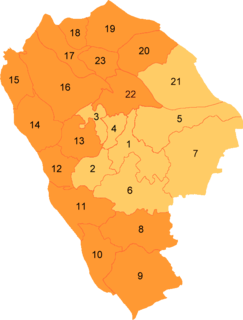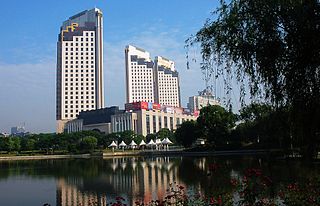This article does not cite any sources .(July 2012) (Learn how and when to remove this template message) |
| Dipu 递铺街道 | |
|---|---|
| Subdistrict | |
 | |
| Coordinates: 30°38′11″N119°41′32″E / 30.63639°N 119.69222°E Coordinates: 30°38′11″N119°41′32″E / 30.63639°N 119.69222°E | |
| Country | People's Republic of China |
| Province | Zhejiang |
| Prefecture-level city | Huzhou |
| County | Anji |
| Time zone | China Standard (UTC+8) |
| Postal code | 313300 |
| Area code(s) | 0572 |
Dipu (simplified Chinese :递铺; traditional Chinese :遞舖; pinyin :Dìpù) is the main town and the seat of Anji County, in northwest Zhejiang province, China. It covers an area of 392 km2 (151 sq mi) and has a population of 158,000.[ when? ] There are 48 villages and 12 communities within its area. Zhejiang Provincial Highway 4 runs through the town.

Simplified Chinese characters are standardized Chinese characters prescribed in the Table of General Standard Chinese Characters for use in mainland China. Along with traditional Chinese characters, they are one of the two standard character sets of the contemporary Chinese written language. The government of the People's Republic of China in mainland China has promoted them for use in printing since the 1950s and 1960s to encourage literacy. They are officially used in the People's Republic of China and Singapore.

Traditional Chinese characters are Chinese characters in any character set that does not contain newly created characters or character substitutions performed after 1946. They are most commonly the characters in the standardized character sets of Taiwan, of Hong Kong and Macau, and in the Kangxi Dictionary. The modern shapes of traditional Chinese characters first appeared with the emergence of the clerical script during the Han Dynasty, and have been more or less stable since the 5th century.
Hanyu Pinyin, often abbreviated to pinyin, is the official romanization system for Standard Chinese in mainland China and to some extent in Taiwan. It is often used to teach Standard Mandarin Chinese, which is normally written using Chinese characters. The system includes four diacritics denoting tones. Pinyin without tone marks is used to spell Chinese names and words in languages written with the Latin alphabet, and also in certain computer input methods to enter Chinese characters.
Dipu is 200 km (120 mi) from Shanghai and 65 km (40 mi) from Hangzhou, the provincial capital. It is within a 3-hour drive of many other cities in the Yangtze River Delta, including Ningbo, Suzhou and Nanjing. The name of the town origins from "Post" because the town was a mail post in ancient China. There is a Post Plaza (Chinese:驿站广场; pinyin:Yìzhàn Guǎngchǎng) on the bank of the town's main river.

Shanghai is one of the four municipalities under the direct administration of the central government of the People's Republic of China, the largest city in China by population, and the second most populous city proper in the world, with a population of 24.18 million as of 2017. It is a global financial centre and transport hub, with the world's busiest container port. Located in the Yangtze River Delta, it sits on the south edge of the estuary of the Yangtze in the middle portion of the East China coast. The municipality borders the provinces of Jiangsu and Zhejiang to the north, south and west, and is bounded to the east by the East China Sea.

Hangzhou formerly romanized as Hangchow, is the capital and most populous city of Zhejiang Province in East China. It sits at the head of Hangzhou Bay, which separates Shanghai and Ningbo. Hangzhou grew to prominence as the southern terminus of the Grand Canal and has been one of the most renowned and prosperous cities in China for much of the last millennium. The city's West Lake, a UNESCO World Heritage site immediately west of the city, is among its best-known attractions. A study conducted by PwC and China Development Research Foundation saw Hangzhou ranked first among "Chinese Cities of Opportunity". Hangzhou is also considered a World City with a "Beta+" classification according to GaWC.

The Yangtze River Delta or YRD is a triangle-shaped metropolitan region generally comprising the Wu Chinese-speaking areas of Shanghai, southern Jiangsu province and northern Zhejiang province. The area lies in the heart of the Jiangnan region, where Yangtze River drains into the East China Sea. The urban build-up in the area has given rise to what may be the largest concentration of adjacent metropolitan areas in the world. It covers an area of 99,600 square kilometres (38,500 sq mi) and is home to over 115 million people as of 2013, of which an estimated 83 million is urban. If based on the greater Yangtze River Delta zone, it has over 140 million people in this region. With about 1/10 of China's population and 1/5 of the country's GDP, the YRD is one of the fastest growing and richest regions in East Asia measured by purchasing power parity. Having a fertile soil, the Yangtze River Delta abundantly produces grain, cotton, hemp and tea. In 2018, the Yangtze River Delta had a GDP of approximately US$2.2 trillion, about the same size as Italy.


















